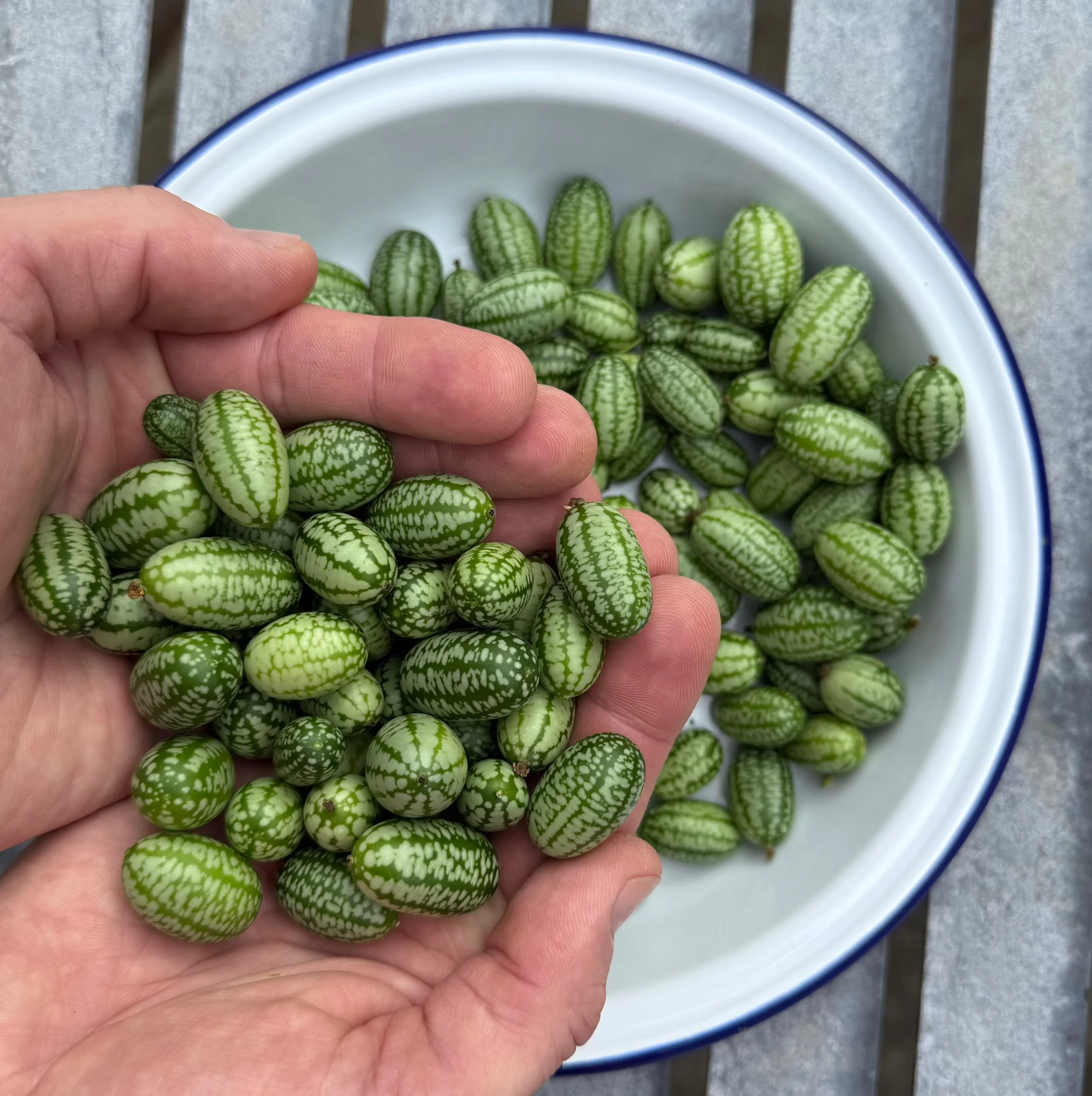The Mouse Melon’s Secret Past
The cucamelon is a jewel of a fruit
An ancient fruit, small in stature but rich in story
At first glance, the cucamelon looks like a modern novelty destined for Instagram fame — a miniature watermelon, the size of a grape, with a cucumber-like cross section, satisfying big crunch and a cucumber taste with a hint of tangy lime. When one of the Tuesday Team of gardeners first planted it, I’ll admit I was sniffy: it seemed a gimmick, some odd modern hybrid. But a little Googling — and the sudden puzzle of what to do with the hundreds of fruits a single vine produces — changed my mind. These tiny fruits (Melothria scabra) are no Frankenstein invention at all, but heirs to a heritage that stretches back centuries to the heart of Central America.
A Fruit of the Ancients
Long before European explorers set foot on the continent, the cucamelon was cherished by the Aztecs and other pre-Columbian peoples. Known in Spanish as sandíita or sandía ratón — “little watermelon” or “mouse melon” — it was valued not only for its refreshing bite but also for its toughness in the garden.
Small though they are, cucamelons flourish where fussier crops falter. Drought-tolerant, resistant to many of the pests that plague cucumbers, and happy to churn out fruit all summer, they’re proof that gardeners long ago knew how to coax abundance from the stingiest soil.
The earliest scientific description of Melothria scabra was by the French botanist Charles Victor Naudin in 1866.
Flavour and Folklore
On the tongue, cucamelons surprise, that refreshing tang that explains their enduring popularity in Mexican kitchens, that like punchy tastes. There, they’re eaten straight from the vine, tossed with chilli, salt, and lime juice, or preserved in brine like tiny gherkins.
In these dishes we glimpse a philosophy of eating that values sharpness and freshness, and that quietly insists on saving plenty for leaner months.
A Modern Rediscovery
For much of recent history, the cucamelon was overshadowed by its bigger cousins. But in the early 2000s, heritage seed collectors reintroduced it to gardeners in Europe and North America. The charm was instant: a plant that felt whimsical yet hardy, ancient yet novel.
In an era hungry for lost flavours, the cucamelon arrived like a secret whispered back from the past — a fruit that carried memory as well as taste, equally at home in a Somerset glssshouse, city balconies, and in the imaginations of cooks keen for something rare but rooted. We planted pots inside and out. The one under glass were more productive - double the crop, although those in the fresh air fruited well.
Cucamelons in the Kitchen
Today, the cucamelon often wears the “superfood” label, though that feels almost beside the point. Its real magic is in the way it bridges old traditions and new tables. Fresh, it brings brightness and beauty to salads, its mottled green skin and neat crunch stealing the show. Pickled, it becomes a sharp companion to roasted meats. And when simmered with grapes into a chutney, it adds bite and freshness to the jammy depths of autumn preserves.
A Fruit to Treasure
Tending cucamelons means stepping into a lineage of gardeners that stretches back to the Aztecs. In the palm, they resemble toy watermelons; on the vine, they gleam like green beads among curling tendrils. They remind us that even the smallest fruits can carry the weight of history — and that sometimes, regeneration begins with rediscovering what was nearly overlooked.
Fancy growing these in your own glasshouse? Purchase cucamelon seeds from our collaborator Pennard Plants.
Try out our recipe for cucamelon and grape chutney.
